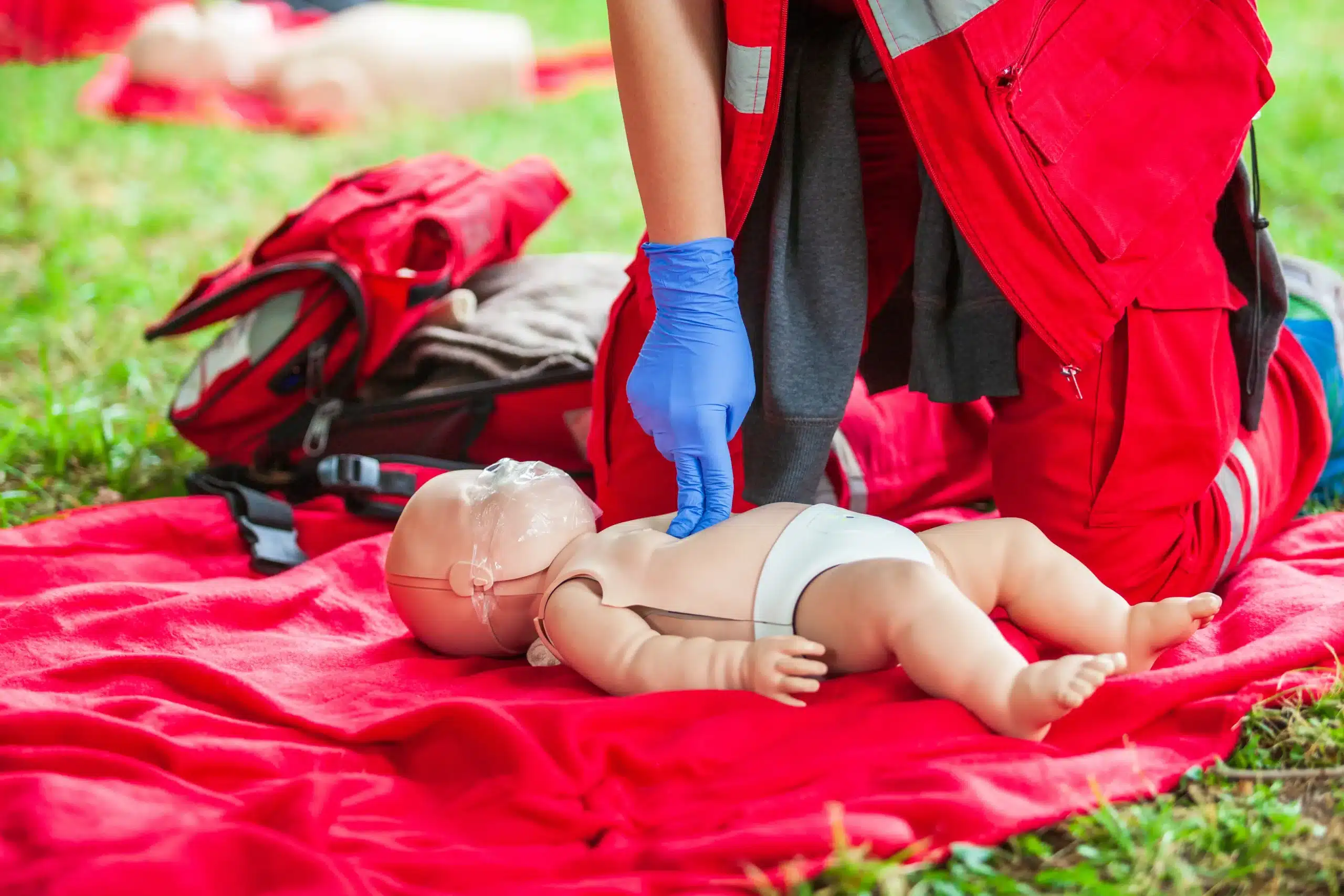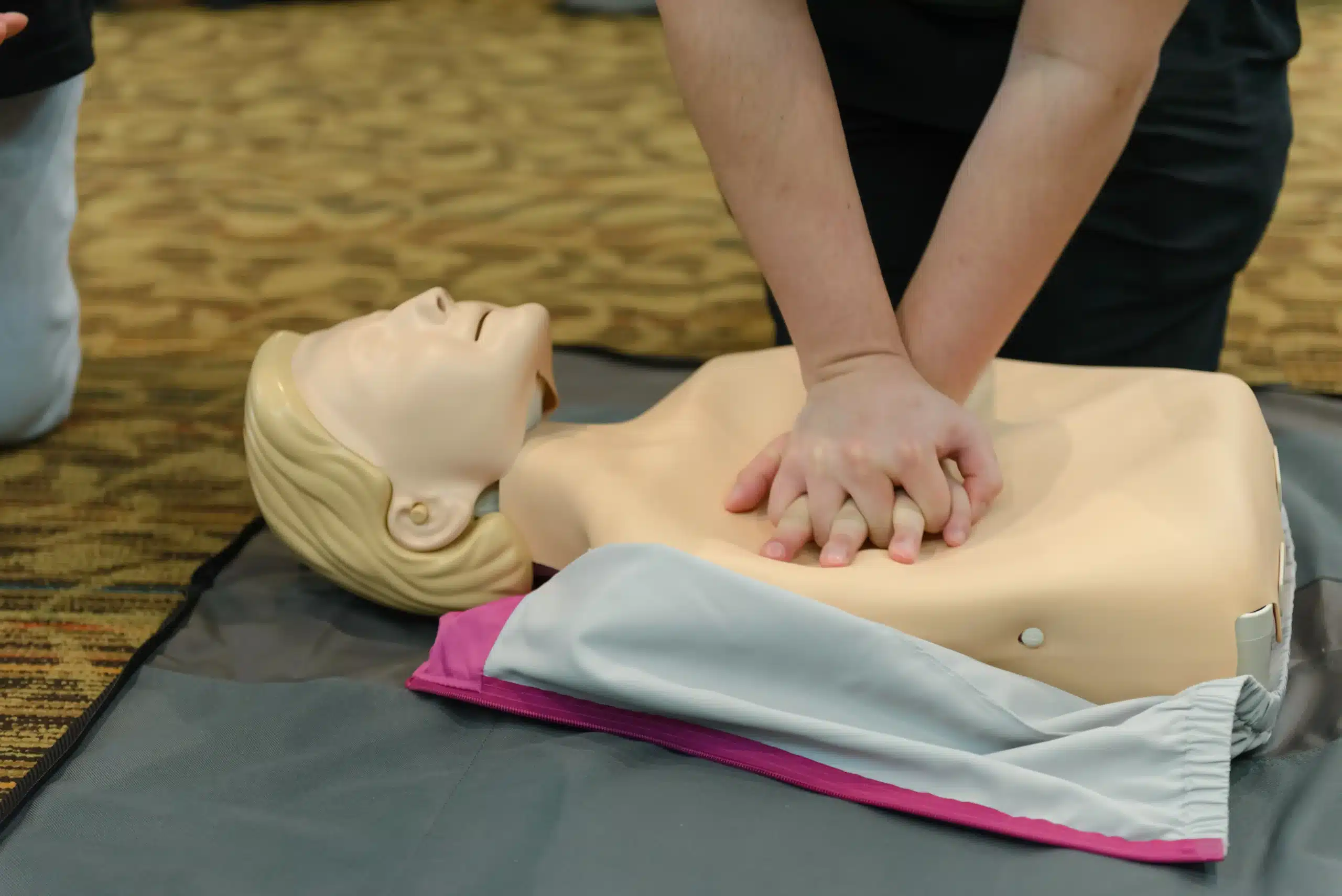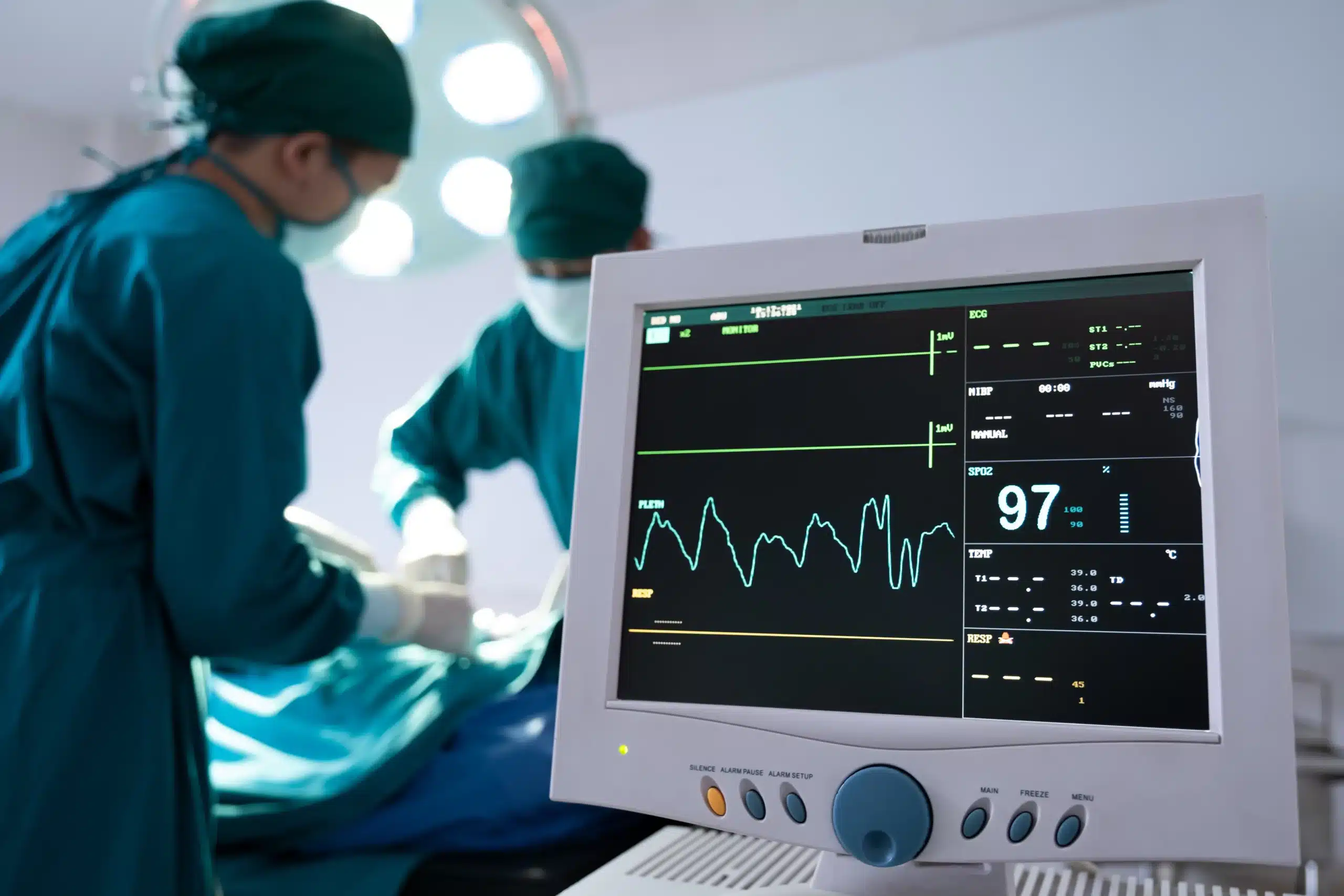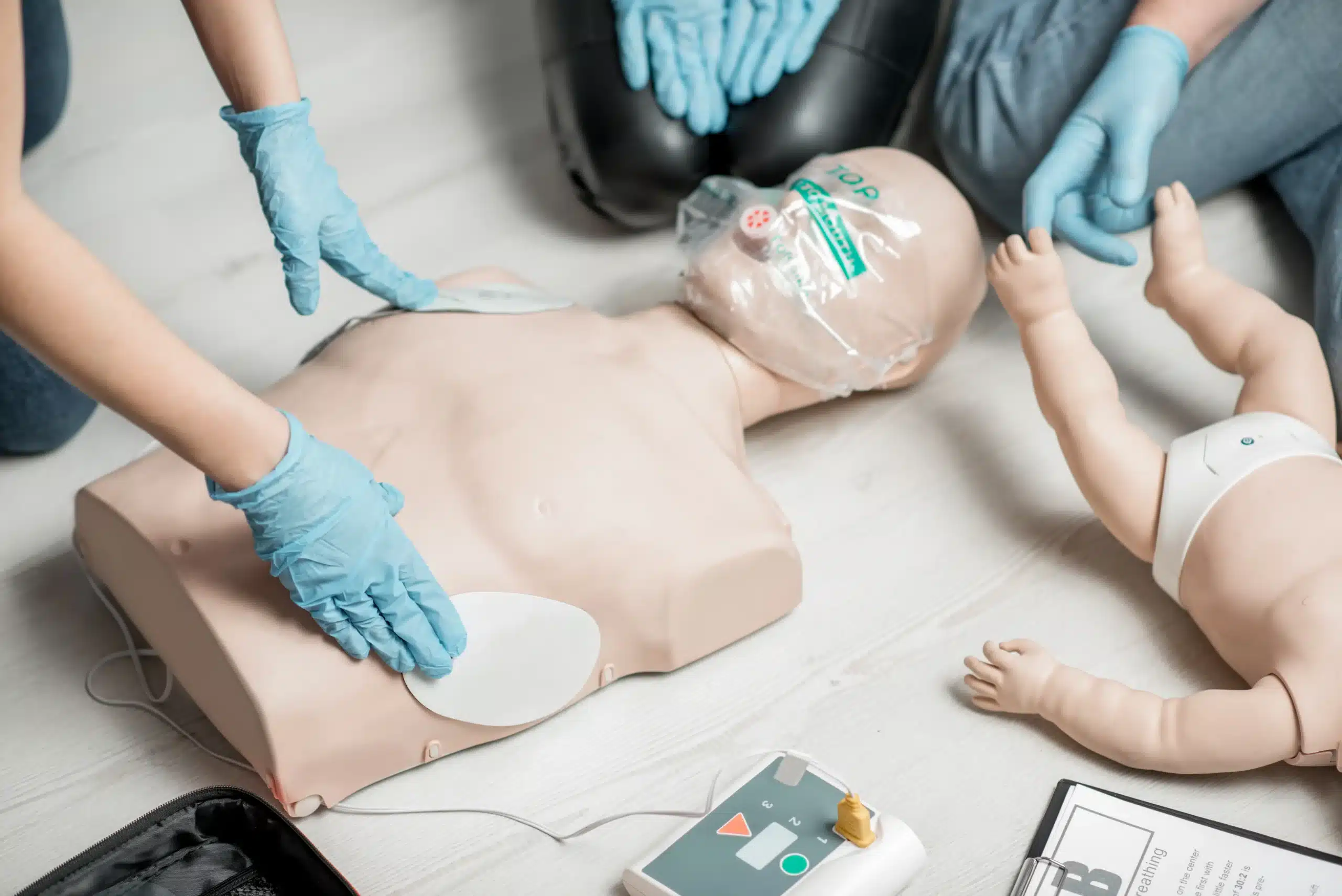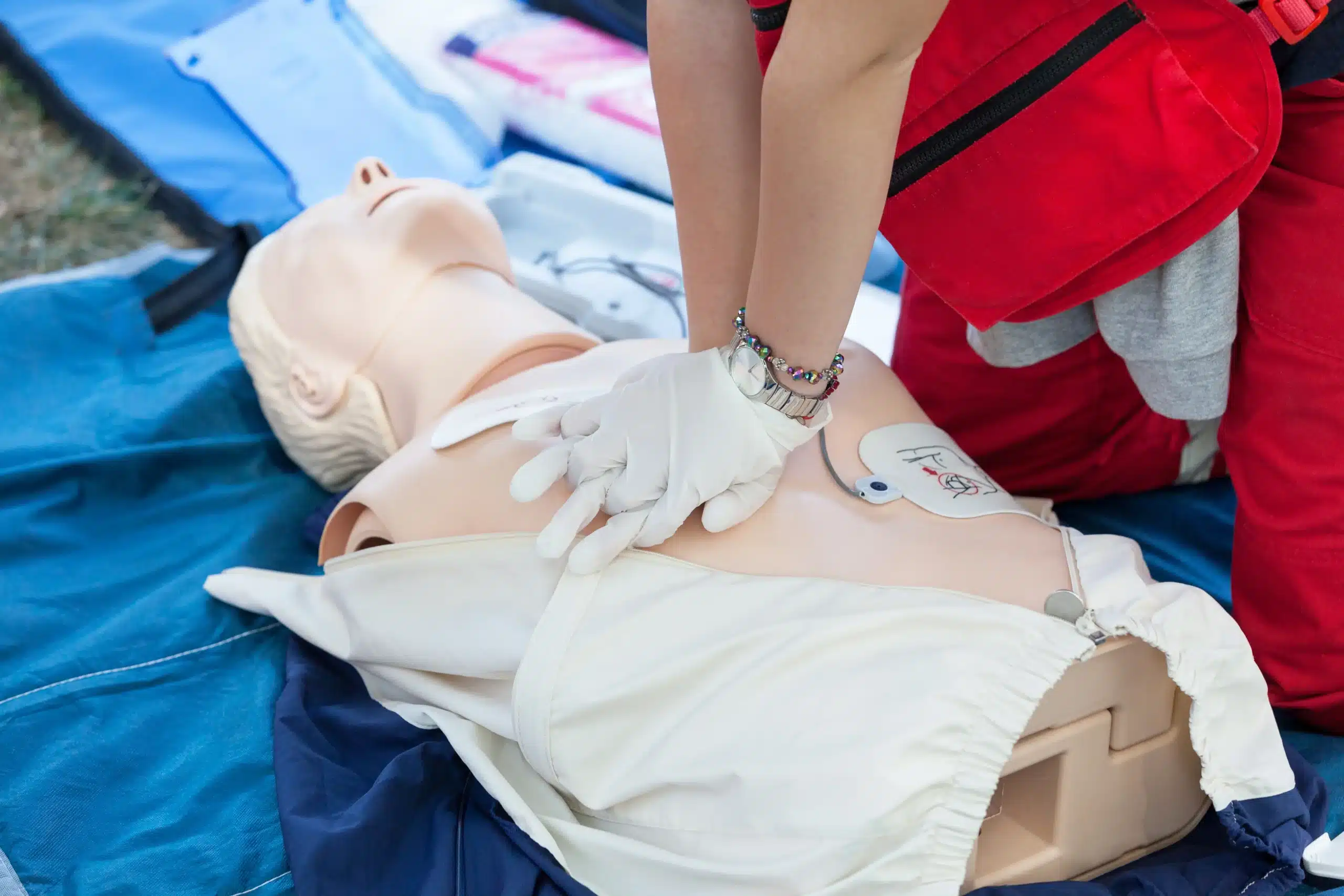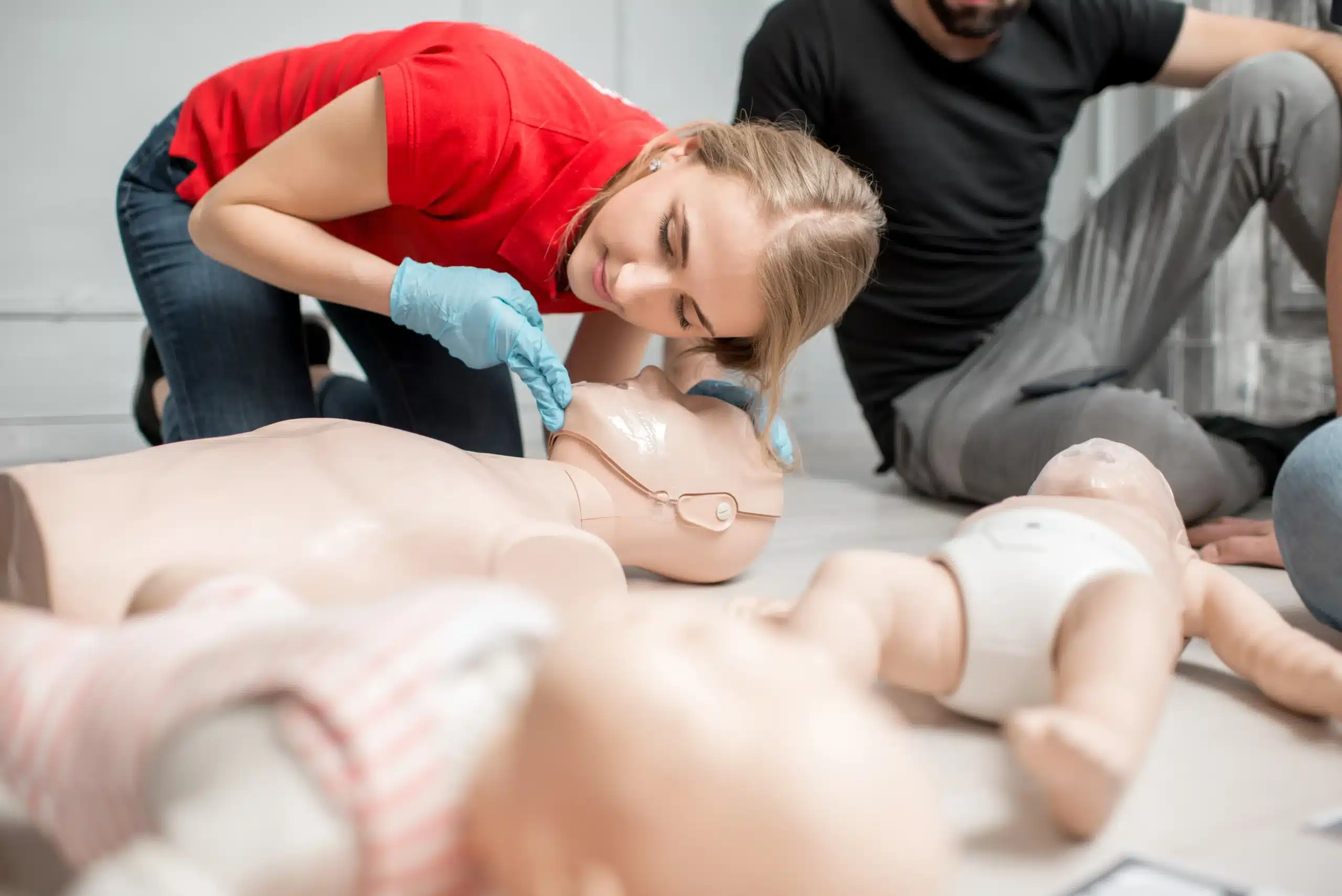First-aid training is an invaluable skill that everyone should consider learning. It empowers you to respond effectively to medical emergencies, providing critical care until professional help arrives. If you’re searching for “first-aid classes near me,” this guide will help you find the perfect training program. We’ll cover the essential skills you’ll learn, the different types of first-aid courses available, and where to find training in your area. We’ll also discuss the costs of training, the benefits of certification, and how to maintain your skills. Let’s equip you with the knowledge and confidence to make a real difference.
Key Takeaways
- First-aid skills are for everyone: Learning first aid empowers you to handle medical emergencies, big or small, providing essential care until professional help arrives. Explore the various course options available, including online, in-person, and blended learning formats, to find the best fit for your lifestyle.
- Choose the right training for your needs: Whether you’re a healthcare professional, childcare provider, or simply want to be prepared for anything, select a course that aligns with your goals. From basic CPR/AED training to specialized certifications like BLS and PALS, there’s a course for everyone.
- Maintain your skills: First-aid knowledge requires upkeep. Stay current with refresher courses and practice regularly to ensure you can confidently and effectively respond to emergencies when it matters most.
What are First-Aid Classes?
First-aid classes teach you how to respond to emergencies, equipping you with practical skills to help someone experiencing a sudden illness or injury. These classes cover a range of situations, from minor cuts and burns to more serious events like heart attacks and strokes. Learning first-aid empowers you to provide immediate care until professional medical help arrives, potentially making a life-saving difference. At Safety Training Seminars, we offer comprehensive first-aid training, including CPR certification for individuals and groups.
Key Skills You’ll Learn
In a typical first-aid class, you’ll gain essential lifesaving skills. These include CPR for adults, children, and infants, how to use an AED, and techniques to control bleeding. You’ll also learn how to recognize and respond to common medical emergencies like choking, strokes, and heart attacks. Many courses combine online learning with in-person sessions for hands-on practice with certified instructors. This blended approach ensures you gain both theoretical knowledge and practical experience. Our PALS certification course at Safety Training Seminars covers many of these essential skills, giving you the confidence to act in emergencies.
Why First-Aid Training Matters
First-aid training is incredibly important. Knowing how to perform CPR can significantly increase someone’s chances of survival after a heart attack. It also equips you to handle a wide range of other emergencies, from minor injuries to life-threatening situations. Having these skills not only allows you to help others but also gives you the confidence to respond effectively under pressure. For healthcare providers seeking efficient certification renewal, our RQI program offers a streamlined approach. Ultimately, first-aid training empowers you to make a real difference in someone’s life. It’s about being prepared, knowing what to do, and having the confidence to act when it matters most. Browse our Northern CA CPR directory to find more resources and training options near you.
Types of First-Aid Classes
Knowing which first-aid course best suits your needs can feel overwhelming with so many options. This section breaks down common first-aid and CPR class types to help you choose the right one.
CPR and AED Training
CPR and AED training teaches you how to respond to cardiac emergencies. You’ll learn to recognize the signs of a heart attack and stroke, perform chest compressions, and use an AED. These skills are invaluable in any setting, as cardiac emergencies can happen anywhere. CPR and AED certifications are often a prerequisite for other healthcare training. Organizations like the American Red Cross and the American Heart Association offer CPR and AED training courses.
Basic Life Support (BLS)
Basic Life Support (BLS) certification goes further than basic CPR and AED training. It’s designed for healthcare providers and other professionals who need a deeper understanding of life-saving techniques. BLS covers advanced airway management, high-quality CPR, and team dynamics during resuscitation. BLS courses often include a focus on using a bag valve mask (BVM) and other medical equipment. You can find BLS training through organizations like the American Heart Association and at our Brentwood location. The cost of BLS training varies but typically starts around $80.
Specialized First-Aid Courses
Beyond general first-aid and CPR/AED training, you can find specialized courses that address specific situations or age groups. Pediatric Advanced Life Support (PALS) focuses on the emergency care of infants and children. You can find more information on our PALS courses on our website. Advanced Cardiovascular Life Support (ACLS) covers advanced life support for adults. Other specialized courses might focus on wilderness first aid or first aid for specific industries. For example, childcare providers may be interested in our EMSA Child Care Health & Safety course. These courses are often offered by organizations like the American Heart Association and the American Academy of Pediatrics. Many providers offer these courses in various formats, including online, in-person, and blended learning. We offer discount group classes for many of our courses.
Find First-Aid Classes Near You
Finding the right first-aid class is easier than you think. With various options available, from online courses to in-person training, you can find a program that fits your schedule and learning style. Here’s a breakdown of where to look:
Online Resources and Platforms
Online learning is a convenient way to learn first aid from home. Sites like the American Red Cross offer various online, in-person, and blended learning courses covering everything from basic first aid and CPR to more specialized topics. Class Central acts as a search engine for online courses, including a curated selection of first-aid programs. Providers like Healthline First Aid offer online options for AHA-certified CPR, first aid, and AED training.
Local Community Centers and Organizations
Your local community is a great place to find first-aid training. Many community centers and organizations offer affordable or even free classes. Check with your local YMCA, recreation centers, or community health organizations. Community-based training plays a vital role in ensuring people have the skills to respond to emergencies, as highlighted in this article on rural CPR access. Organizations like Streetfriends demonstrate how first-aid and CPR training can be integrated into community initiatives.
Health Organizations and Hospitals
Hospitals and health organizations are natural hubs for first-aid and CPR training. The American Heart Association offers resources and information on finding training in your area. You can also check with local hospitals or organizations like ASHI to find certified training centers nearby. These organizations often provide various courses, from basic to advanced levels.
Choose the Right Class Format
Deciding on the right first-aid class format depends on your learning style, schedule, and budget. Let’s break down the pros and cons of each option so you can make the best choice.
In-Person Training
In-person classes provide hands-on learning with a certified instructor. This format is ideal for those who learn best through direct interaction and practice. You’ll work with training manikins and other equipment, developing muscle memory and confidence in your skills. In-person training ensures you meet OSHA workplace requirements and typically provides a two-year certification. Plus, having an instructor present allows for immediate feedback and answers to any questions. If you thrive in a structured, interactive environment, in-person training might be your best bet. Our classes at Safety Training Seminars offer a relaxed and supportive learning environment, with instructors ready to guide you every step of the way. Check out our discount group class options for an even more affordable way to learn in person.
Online Courses
Online first-aid courses offer flexibility and convenience. You can learn at your own pace, anytime, anywhere, from your laptop or tablet. This format often works well for busy schedules or those who prefer self-directed learning. Online options are generally more affordable than in-person classes and cover essential first-aid knowledge. However, it’s important to remember that online courses typically don’t include the hands-on skill demonstrations crucial for real-life emergencies. They’re a great way to learn the basics but may not fully prepare you for practical application.
Blended Learning
Blended learning combines online learning with hands-on practice. You’ll get the flexibility of online learning for theoretical concepts, combined with in-person skill sessions. This approach allows you to study at your own pace and then apply what you’ve learned under the guidance of an instructor. Blended learning offers a comprehensive learning experience that caters to various learning styles and schedules. It’s a great option if you want the convenience of online learning with the added benefit of practical application and expert feedback. Consider blended learning if you’re looking for a balanced approach that fits your busy lifestyle while still providing essential hands-on training.
Understand First-Aid Training Costs
Knowing the cost of first-aid training is an important step in choosing the right class. While prices vary, understanding typical ranges and potential discounts can help you budget effectively. We’ll also explore how first-aid training might even impact your insurance coverage.
Average Price Ranges
First-aid training costs depend on several factors, including the type of course, your location, and the training provider. Basic adult CPR classes typically cost between $20 and $55, while pediatric CPR classes range from $25 to $40. A combined CPR and first-aid course usually costs somewhere between $40 and $60. BLS CPR and AED training is often priced around $80, with first-aid certification adding another $20. For those looking to train a team, group rates for workplace CPR training (for a minimum of eight participants) generally fall between $35 and $45 per person. Safety Training Seminars offers discounted group rates for businesses looking to certify their employees. You can also explore additional courses like the American Heart Association PALS course offered by Safety Training Seminars.
Discounts and Group Rates
Many training centers offer discounts for group classes, a smart way for organizations to train their staff cost-effectively. This can be a significant saving, especially for larger businesses. Some providers offer combined AHA-certified CPR and first-aid training for a single price. Personalized group classes can also be a great option, allowing for tailored training that meets specific workplace needs while remaining budget-friendly. Check with your local providers or Safety Training Seminars to see what group discounts are available. For medical professionals seeking efficient certification options, Safety Training Seminars provides a unique RQI program, supported by a dedicated customer service team.
Insurance Coverage
In many industries, especially healthcare and outdoor-related fields, employers require first-aid and CPR certification. This creates a safer work environment and can also influence business insurance coverage. Having trained employees can minimize risks and potentially lower insurance premiums. Check with your insurance provider to understand how first-aid and CPR training might affect your coverage. For those in the childcare field, consider exploring the EMSA Child Care Health & Safety training. If you’re looking for other valuable resources, take a look at the Northern CA CPR Directory. Safety Training Seminars also offers the American Academy of Pediatrics NRP course.
What to Expect in Class
So, you’ve signed up for a first-aid class—congratulations! Knowing what to expect can help you feel prepared and ready to learn. Here’s a glimpse into a typical first-aid class:
Course Content Overview
First-aid classes cover a broad range of essential life-saving skills. You’ll learn how to respond to various medical emergencies, from minor injuries like cuts and burns to more serious situations like heart attacks and strokes. Expect to learn about recognizing the signs of these emergencies, providing initial care, and when to call for professional help. A significant portion of the class will focus on CPR and AED training for adults, children, and infants, including chest compressions and rescue breaths. You’ll also learn techniques for stopping bleeding, managing choking incidents, and other critical first-aid procedures. Many courses, like those offered by the American Red Cross, also incorporate injury prevention strategies.
Hands-On Practice
Hands-on practice is the cornerstone of effective first-aid training. Most classes, whether in-person or blended learning (a combination of online and in-person sessions), emphasize practical application. You’ll have the chance to practice skills like bandaging wounds, applying splints, and performing CPR on mannequins in a safe and supportive learning environment. This hands-on experience is invaluable for building muscle memory and the confidence to act quickly and efficiently during a real emergency. The Red Cross highlights the importance of this practical training.
Assessment Methods
To ensure you’ve mastered the material, first-aid classes typically involve both practical demonstrations and written exams. You’ll demonstrate your skills in front of the instructor and answer questions related to the course content. Upon successful completion, you’ll receive certification, which is often required for certain jobs and volunteer opportunities. This certification validates your skills and provides peace of mind knowing you’re equipped to handle emergencies. Remember to keep track of your certification expiration date and stay up-to-date with the latest first-aid guidelines.
Certifications and Their Value
Getting certified in first aid, CPR, or other related skills isn’t just about a piece of paper—it’s about having the confidence and skills to potentially save a life. These certifications demonstrate your competence to employers, schools, or even just your family and friends. Let’s explore the different types of certifications, how long they’re valid, and why they’re so valuable.
Types of Certifications
Several organizations offer various first-aid and related certifications. You can find certifications in general first aid, CPR/AED (using an automated external defibrillator), Basic Life Support (BLS), Pediatric Advanced Life Support (PALS), and even specialized courses like the Neonatal Resuscitation Program (NRP). The type of certification you pursue often depends on your personal or professional goals. For example, healthcare providers often pursue BLS certification while childcare providers might opt for CPR and first-aid training. Consider what situations you’re most likely to encounter and choose your certification accordingly.
Validity and Renewal
Most first-aid and CPR certifications are valid for about two years. This isn’t arbitrary—guidelines and best practices can change, and renewing your certification ensures your skills and knowledge are up-to-date. Recertification usually involves taking a refresher course that covers any updates and allows you to practice your skills. Keeping your certification current demonstrates your ongoing commitment to safety and preparedness.
Professional and Personal Benefits
The value of first-aid certification extends beyond the workplace. Professionally, having these skills can open doors to job opportunities, especially in fields like healthcare, education, and childcare. Some employers even require first aid and CPR certification as a condition of employment. Personally, knowing how to respond to emergencies can give you peace of mind in your daily life. Whether you’re at home, out with friends, or traveling, you’ll be equipped to handle unexpected medical situations. First-aid training empowers you to assist others in need and potentially make a life-saving difference. It’s an investment in yourself, your community, and the well-being of those around you. Consider checking out resources like the Northern CA CPR Directory for more information. If you’re looking for cost-effective options, explore group discounts for first-aid classes.
Prepare for Your First-Aid Class
So, you’ve decided to take a first-aid class—fantastic! Being prepared will make your learning experience even better. Here’s how to get ready:
Required Materials
Most first-aid courses don’t require you to bring anything specific. Your instructor will provide any necessary equipment for hands-on practice, like bandages, CPR mannequins, and AED trainers. However, it’s always a good idea to have a notebook and pen to jot down notes. Some students find it helpful to familiarize themselves with the contents of a small first-aid kit. If you’re taking an online course through a provider like the American Red Cross, ensure you have a reliable internet connection and a device you’re comfortable using.
Pre-Course Study Tips
While not mandatory, reviewing some basic first-aid concepts beforehand can give you a head start. Websites like First Aid for Free offer accessible online resources. Brushing up on topics like CPR or how to control bleeding can make in-class learning more efficient. Think about your learning style, too. The Red Cross offers various course formats—in-person, online, and blended learning—so you can choose what suits you best. Finally, take a moment to debunk any first-aid myths you might have heard. Understanding the realities of first aid, as discussed in this article on debunking first aid myths, can help you appreciate the importance of this training.
Maintain Your First-Aid Skills
Knowing what to do in a medical emergency can make all the difference. But like any skill, first aid requires regular practice. Staying up-to-date on the latest techniques ensures you can respond effectively when needed.
Refresher Courses
First-aid certifications typically expire after two years. Enrolling in refresher courses is the best way to keep your skills sharp and your certification current. These courses reinforce essential techniques and introduce any updated guidelines. Regular training builds confidence and empowers you to act quickly and efficiently during emergencies. Consider checking with your local fire department or community centers for available refresher courses.
Practice at Home
Beyond formal training, practicing your skills at home is crucial. Regularly reviewing first-aid procedures helps solidify your knowledge and improve your response time in real-life situations. This kind of practice not only reinforces your skills but also helps debunk common first-aid myths, ensuring you’re prepared to provide safe and effective assistance. You can find helpful resources and guides online that offer practical tips and scenarios for practicing various techniques, from treating minor cuts and burns to managing more serious injuries. Even simple refreshers can significantly impact your preparedness and effectiveness in an emergency.
First-Aid Training Providers
Finding the right first-aid training provider is crucial for a high-quality learning experience. Several reputable organizations and institutions offer comprehensive first-aid and CPR training programs. Here are a few options to explore:
American Red Cross
The American Red Cross is a well-known humanitarian organization offering a range of training courses, including first aid, CPR, AED, and BLS. They offer various learning formats, including in-person classes, online courses, and blended learning options. Locate a class near you or choose an online course that fits your schedule through their website.
American Heart Association
The American Heart Association (AHA) is another leading provider of CPR and first-aid training. They offer various courses, including BLS, ACLS, PALS, and Heartsaver programs. The AHA also provides instructor courses, continuing education modules, and other specialized training options. You can find AHA-certified training centers across the country.
Safety Training Seminars
Safety Training Seminars offers various safety courses, including CPR, first aid, and other specialized certifications. They focus on providing practical training and debunking common CPR myths to ensure participants feel confident responding to emergencies. Check their website for course schedules and locations. For those in the Brentwood, CA area, Safety Training Seminars offers American Heart Association courses, including BLS, ACLS, PALS, CPR, and First-Aid. They also offer an RQI program for medical professionals and discounted group CPR classes. Residents of Antioch, Brentwood, and Concord can find convenient local training options. Browse their Northern CA CPR directory for more locations. Those interested in pediatric care can explore their PALS (Pediatric Advanced Life Support) and NRP (Neonatal Resuscitation Program) courses, as well as their EMSA Child Care Health & Safety program.
Local Fire Departments
Many local fire departments offer first-aid and CPR training to community members. Contact your local fire department to inquire about available courses and schedules. These courses are often affordable and convenient for those who prefer in-person instruction.
Community Colleges
Community colleges frequently offer first-aid and CPR training as part of their continuing education programs. These courses are often cost-effective and provide a structured learning environment. Check with your local community college to see what programs they offer.
Related Articles
- The Critical Role of CPR and First-Aid Training in the Workplace
- Find CPR Courses Near Me: A Practical Guide – Brentwood CPR Classes
- Pediatric CPR & First-Aid Training in Concord – Brentwood CPR Classes
- CPR Training in Concord: Find Right Course for You
- Online CPR Classes in Brentwood: A Complete Guide
Frequently Asked Questions
What’s the difference between CPR and First Aid? CPR, or Cardiopulmonary Resuscitation, focuses specifically on reviving someone whose heart has stopped or who isn’t breathing. First aid covers a much broader range of medical emergencies, from minor cuts and burns to more serious situations like strokes and seizures. CPR is often included as a key component within first-aid training.
How do I choose the right first-aid class? Think about your specific needs and interests. If you’re looking for basic life-saving skills, a standard CPR/First Aid course is a great starting point. Healthcare providers usually need more advanced training like BLS or ACLS. If you work with children, look into PALS or EMSA Child Care Health & Safety. Consider your learning style, too. Do you prefer in-person instruction, the flexibility of online learning, or a blended approach?
How much does first-aid training cost? Costs vary depending on the course type, location, and provider. Basic first-aid and CPR classes typically range from $20 to $80. More specialized courses like BLS, PALS, or ACLS tend to be more expensive. Many providers offer discounts for groups, so if you’re training with colleagues or friends, be sure to ask about group rates.
Where can I find first-aid classes near me? Check with organizations like the American Red Cross and the American Heart Association, as they often have training centers across the country. Local hospitals, community centers, and even fire departments frequently offer first-aid classes. You can also search online for certified instructors in your area. Safety Training Seminars offers a variety of courses, including those specifically for the Brentwood, CA community.
How long is a first-aid certification valid, and how do I renew it? Most first-aid certifications are valid for two years. To renew, you’ll typically need to take a refresher course. This ensures your skills and knowledge are up-to-date with the latest guidelines. Check with your certifying organization for specific renewal requirements.


